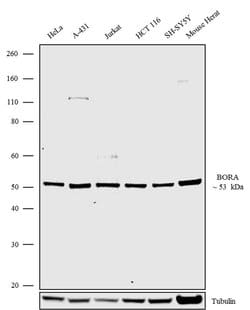Learn More
Invitrogen™ Bora Recombinant Superclonal™ Antibody (10HCLC)
Rabbit Recombinant Superclonal Antibody
Supplier: Invitrogen™ 711180
Description
This antibody is predicted to react with Monkey, Horse, Bovine and Sheep Recombinant rabbit Superclonal™ antibodies are unique offerings from Thermo Fisher Scientific. They are comprised of a selection of multiple different recombinant monoclonal antibodies, providing the best of both worlds - the sensitivity of polyclonal antibodies with the specificity of monoclonal antibodies - all delivered with the consistency only found in a recombinant antibody. While functionally the same as a polyclonal antibody - recognizing multiple epitope sites on the target and producing higher detection sensitivity for low abundance targets - a recombinant rabbit Superclonal™ antibody has a known mixture of light and heavy chains. The exact population can be produced in every lot, circumventing the biological variability typically associated with polyclonal antibody production. Note: Formerly called Recombinant polyclonal antibody, this product is now rebranded as Recombinant Superclonal™ antibody. The physical product and the performance remain unchanged.
Bora (Protein aurora borealis) is a key activator of Aurora Related Protein Kinase A (ARK-1), which is a centrosome-associated serine/threonine kinase that regulates centrosome maturation, bipolar spindle assembly and chromosome segregation during mitosis. Bora is localized to the nucleus until mitosis is initiated, then translocates to the cytoplasm in a Cdc2 dependent manner. Activation of Cdc2 initiates the release of Bora into the cytoplasm where it can bind and activate ARK-1. PLK1 (polo-like kinase-1) interacts with Bora to control the accessibility of its activation loop for phosphorylation and activation by ARK-1. Bora and ARK-1 cooperatively activate PLK1 and control mitotic entry. Bora mutants result in multipolar spindles in mitosis identical to those observed when ARK-1 function is blocked. Thus, the ARK1-Bora-PLK1 regulatory circuit in mammalian cells elucidates a key mechanism in cell cycle regulation. At least three isoforms of Bora are known to exist.
Specifications
| Bora | |
| Recombinant Superclonal | |
| 0.5 mg/mL | |
| PBS with 0.09% sodium azide; pH 7.2 | |
| Q6PGQ7, Q8BS90 | |
| BORA | |
| Protein corresponding to Human BORA (aa 274-456). | |
| 100 μg | |
| Primary | |
| Human, Mouse | |
| Antibody | |
| IgG |
| Western Blot | |
| 10HCLC | |
| Unconjugated | |
| BORA | |
| 6720463M24Rik; AI317232; aurora borealis; BORA; bora, aurora kinase A activator; C13orf34; HsBora; Protein aurora borealis; RGD1309522; RP11-342J4.2 | |
| Rabbit | |
| Protein A | |
| RUO | |
| 77744, 79866 | |
| Store at 4°C short term. For long term storage, store at -20°C, avoiding freeze/thaw cycles. | |
| Liquid |
Safety and Handling
Your input is important to us. Please complete this form to provide feedback related to the content on this product.
